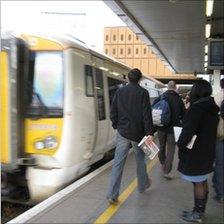Rail travel at highest peacetime level since 1928
- Published

Rail passengers saw fares rise by an average of 6.2% this year
Train travel is at its highest peacetime level since the 1920s, according to the Association of Train Operating Companies (Atoc).
The number of train journeys in Great Britain reached 1.3bn in 2010, a figure not seen since 1928.
Atoc said it was down to a mix of good service, attractive pricing and the rising cost of motoring.
But the proportion of Britons using the train is still substantially lower than before World War II.
Since the peak of 1.3bn in 1928, the number of annual rail journeys taken in England, Scotland and Wales fell back steadily to its most recent low point in the early 1980s.
The proportion of people using the train has decreased, while the the amount of useable rail track has more than halved.
Satisfied passengers
Rail users' group Passenger Focus said train companies needed to get their costs down to prevent rail fares - which rose by an average of 6.2% this year - becoming unaffordable for many.
Last week, its annual survey of 31,000 rail travellers found 84% were satisfied, the highest since the poll started in 1999.
At the start of 2011, regulated fares, which include season tickets, went up by an average of 5.8% but some mainline season tickets increased by almost 13%.
Some unregulated fares, typically short distance off-peak ones, rose by more than the 6.2% average.
Tube and bus fares in London went up by an average of 6.8%.
- Published26 January 2011
- Published2 January 2011